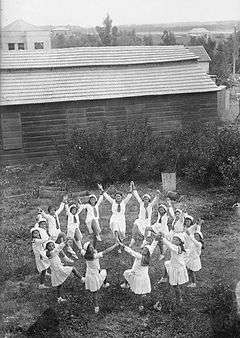Tu B'Av
| Tu B'Av | |
|---|---|
 Dancing girls on Tu B'Av | |
| Official name |
Hebrew: ט"ו באב English: Fifteenth of Av |
| Observed by | Jews |
| Type | Jewish religious and cultural |
| Observances | Tachanun and similar prayers are omitted from daily prayers |
| Date | 15th day of Av |
| 2015 date | Sunset, July 30 – Nightfall, July 31 |
| 2016 date | Sunset, August 18 – Nightfall, August 19 |
Tu B'Av (Hebrew: ט"ו באב, the fifteenth of the month Av) is a minor Jewish holiday. In modern-day Israel, it is celebrated as a holiday of love (Hebrew: חג האהבה, Hag HaAhava), similar to Valentine's Day.[1] It has been said to be a "great day for weddings".
Historical significance
According to the Mishna, Tu B'Av was a joyous holiday in the days of the Temple in Jerusalem, marking the beginning of the grape harvest. Yom Kippur marked the end of the grape harvest. On both dates, the unmarried girls of Jerusalem dressed in white garments, and went out to dance in the vineyards (Babylonian Talmud, tractate Ta'anit 30b-31a).[2] That same section in the Talmud states that there were no holy days as happy for the Jews as Tu B'Av and Yom Kippur.[3] The holiday celebrated the wood-offering brought in the Temple (see Nehemiah 10:35). Josephus refers to it as the Feast of Xylophory ("Wood-bearing").[4]
Various reasons for celebrating on Tu B'Av are cited by the Talmud and Talmudic commentators:[5]
- While the Jews wandered in the desert for forty years, female orphans without brothers could only marry within their tribe, to prevent their father's inherited land in the Land of Israel from passing on to other tribes. On the fifteenth of Av of the fortieth year, this ban was lifted. (See Daughters of Zelophehad.)
- That same year, the last of the generation of the sin of the spies, which had been forbidden to enter the Promised Land, found that they were not destined to die. For forty years, every Tisha B'av night, the Jews made graves for themselves in which they slept on Tisha B'Av; every year a proportion of them died. In the 40th year, the fifteen thousand who had remained from the first generation went to sleep in the graves and woke up the next day to their surprise. Thinking they made a mistake with the date, they did this until they reached Tu B'Av. Only then did they know they were allowed to live.
- The Tribe of Benjamin was allowed to intermarry with the other tribes after the incident of the Concubine of Gibeah (see Judges chapters 19–21).
- Cutting of the wood for the main altar in the Temple was completed for the year.
- The nights, traditionally the ideal time for Torah study, are lengthened again after the summer solstice, permitting more study.
- The Roman occupiers permitted burial of the victims of the massacre at Bethar during the Bar Kochba rebellion. Miraculously, the bodies had not decomposed, despite exposure to the elements for over a year.
Modern times
Tu B'Av marks an informal "high" to counter the "low" of The Three Weeks leading up to Tisha B'Av. Tu B'Av does not have many established religious rituals associated with its celebration. However Tachanun is not said—either at mincha the day before or on the day itself—and a bride and groom traditionally do not fast if their wedding falls on Tu B'Av.[6]
In modern times, it has become a romantic Jewish holiday, often compared to Valentine's Day, and has been said to be a "great day for weddings, commitment ceremonies, renewal of vows, or proposing".[7]
References
- ↑ Tu B'Av: Reclaiming old traditions, Yedioth Ahronoth, Yoav Friedman, August 4, 2009
- ↑ About Tu Be'av
- ↑ Torah learning
- ↑ Bellum Judaisum 2:17
- ↑ Mishna Taanit 4:8 and Babylonian Talmud 30b and 31a, Rashi on these
- ↑ "Tu B'Av". OU.ORG. Retrieved 2010-08-01.
- ↑ Celebrating love